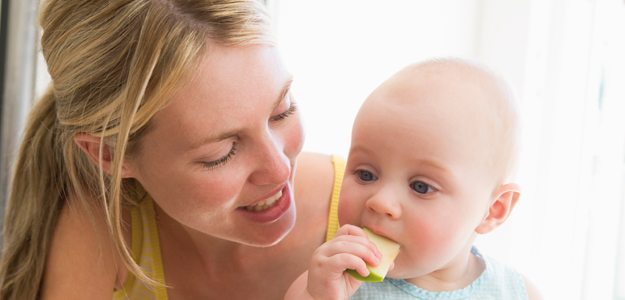
Remember that every baby is different; some parents choose to start weaning slightly earlier, especially if they are bottle-fed. However, the advantage of weaning at six months is that a baby is generally ready to feed himself, and so baby-led weaning from the very start is a very real possibility. If you choose to start with spoon-feeding, it’s possible to incorporate some aspects of baby-led weaning after six months too.
What you will need:
A high chair
Find one that is easy to clean, where your baby can sit with the tray at the right height and distance.
Bibs
Baby-led weaning is messy, so you will need some easy to wash bibs with sleeves plus a bib over the top that can collect dropped food.
Spoons
Make sure you get the shorter self-feeding spoons as the grip is nearer the end and they are slightly deeper.
Beaker
A free-flow beaker with a top for when you are out and about. Make sure the beaker does not contain a valve.
Mess control
You will need something to go on the floor and a splash mat is not going to be good enough. Buy a few cheap table clothes or a shower curtain from the pound shop to completely cover the area surrounding the high chair. Or just make sure you’re nowhere near carpet!
Baby Led Weaning in Ten Steps
- Is your baby ready – are they able to sit up, hold their head up and hold a spoon?
- Food must be prepared so it will stick to a spoon (i.e. porridge) or in a stick shape (i.e. a soft stick of cooked carrot) as your baby will only be able to use their fist initially.
- Forget about a bowl – this will be flung! Simply put the food on the clean plastic high-chair tray.
- You will need to check your baby’s mouth before lying them down after food, as they may not be able to use their tongue to dislodge any food in their cheeks or the roof of their mouth.
- Be ready to do some damage control (there will be food everywhere).
- Avoid salt, sugar and honey (plain fruit and vegetables are best).
- Be prepared for gagging in the initial stages; babies at this age have a very sensitive gag reflex in order to protect against choking. Never leave your child unattended with food and always watch out for potentially hazardous foods. Babies who learn to self-feed may even be at less risk of choking as they quickly learn they need to break down food before swallowing. To prepare, take a paediatric first aid course so you’re ready for any eventuality.
- Let your baby have fun and don’t worry about how much food they actually eat in those first few weeks. Before long you’ll be amazed at how much they get through!
- Keep milk feeds exactly the same to start with and do not sit your baby up to eat if they are too tired or too hungry. Make sure you always offer your baby water at mealtimes.
- Be prepared again: your baby’s poo will change. The colours can be vivid (to say the least!) and it’s common to have undigested foods present.
A typical day plan
Breakfast
Try a spoonful of thick porridge on a spoon plus a couple of strips of mango (keep the skin on so your baby can grip it).
Lunch
An unsalted rice cake with a spread of homemade hummus and a cucumber stick.
Dinner
In a steamer, place a small piece of salmon fillet with a new potato and carrot stick and steam together for 20 minutes.
maternity & infant
Originally posted 2018-06-14 08:27:14.








